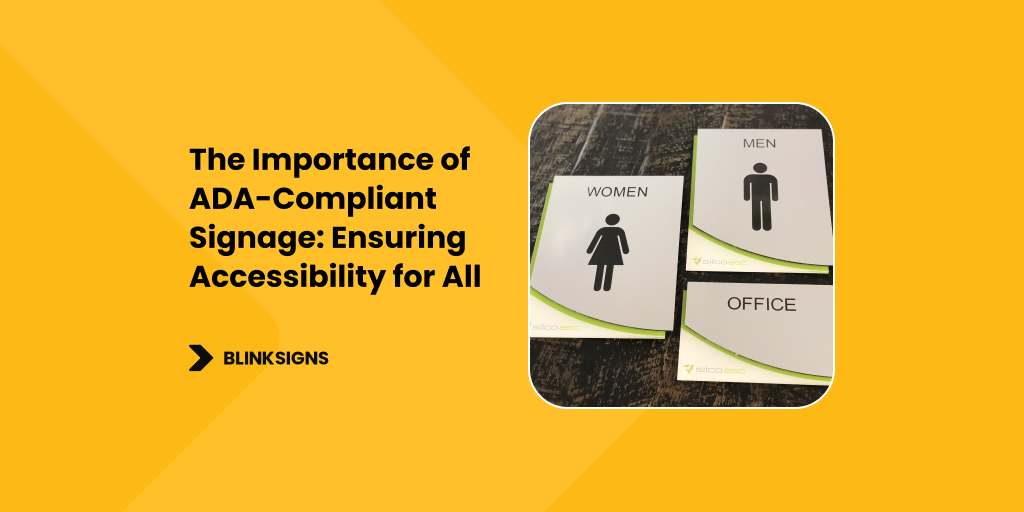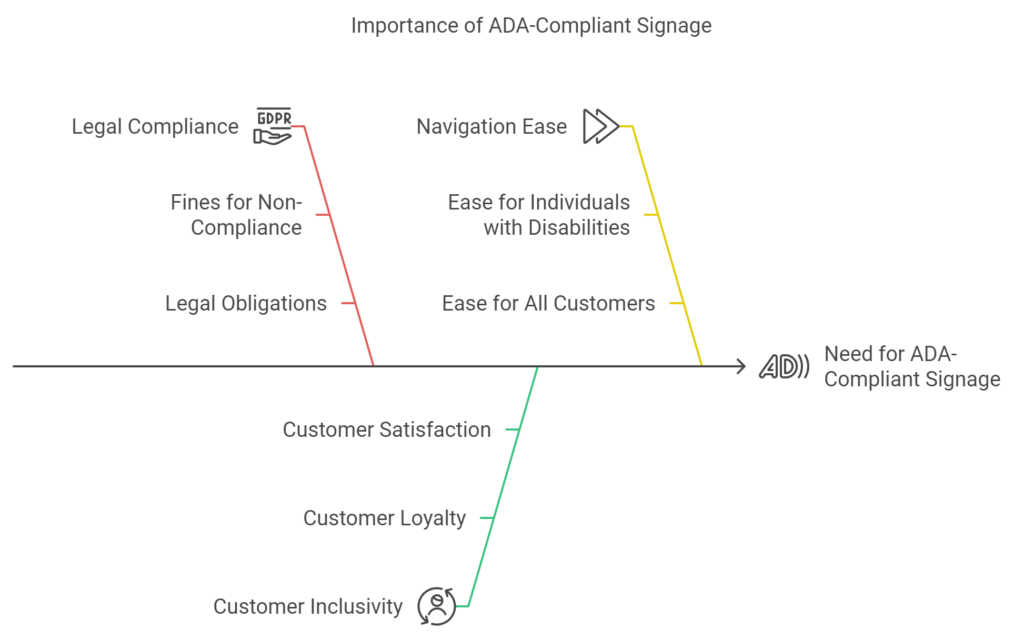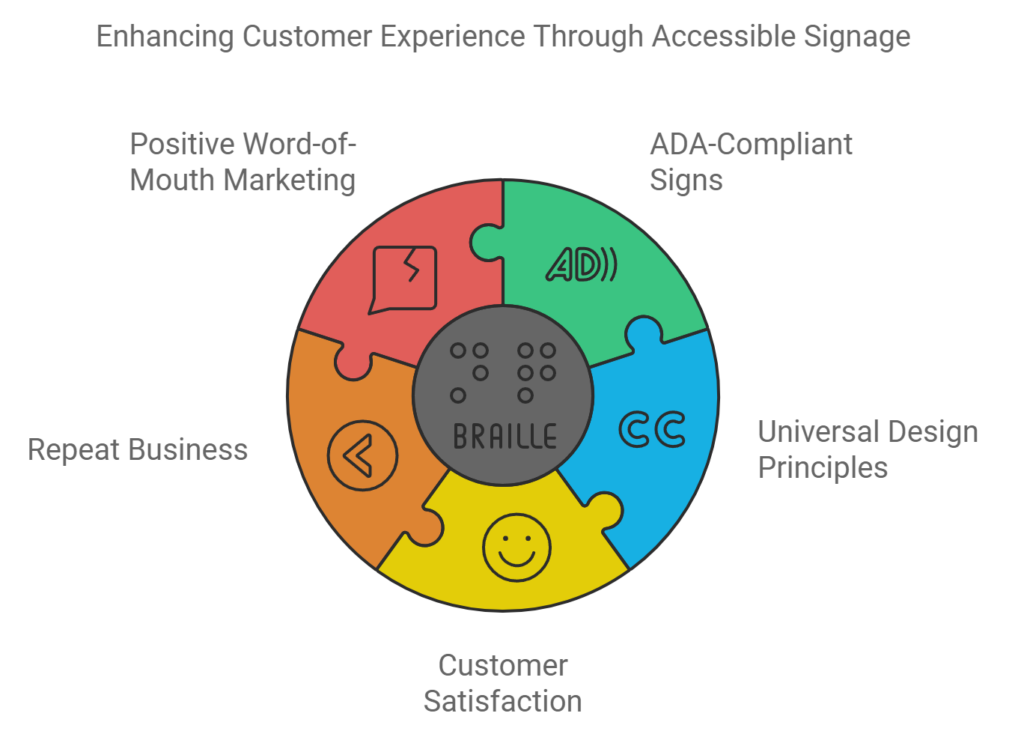
The Importance of ADA-Compliant Signage: Ensuring Accessibility for All
Creating accessible environments is not just a legal requirement—it’s a key aspect of fostering inclusivity and ensuring that everyone, regardless of ability, has equal access to services, businesses, and public spaces. ADA-compliant signage plays a critical role in this process by providing essential information that is easy to understand and navigate for individuals with disabilities.
In this guide, we’ll explore the importance of ADA-compliant signage, its key features, and best practices for designing and implementing accessible signage that aligns with both ADA regulations and your customers’ needs.
What is Ada-compliant signage?
ADA-compliant signage refers to signage that adheres to the Americans with Disabilities Act (ADA) guidelines, a federal law that ensures accessibility to all individuals, particularly those with disabilities. This includes features like Braille, tactile letters, appropriate contrast, and clear fonts that improve readability and navigation for people with visual, auditory, or cognitive impairments.
The ADA establishes specific requirements for sign placement, size, font, and material, making it essential for businesses to follow these standards to provide equal access. Failing to comply with these regulations can not only alienate customers but also result in hefty fines and legal repercussions.
Why ADA Compliance is Critical for Businesses
ADA compliance is crucial for several reasons:
- Legal Obligation: Under the ADA, businesses must provide accessible environments, including signage, for individuals with disabilities. Failure to comply can result in fines of up to $75,000 for a first violation and $150,000 for subsequent violations.
- Inclusivity and Accessibility: By creating accessible spaces with proper signage, businesses can ensure all customers feel welcomed and valued, increasing customer loyalty and satisfaction.
- Improved Navigation: ADA-compliant signage makes it easier for everyone, including those without disabilities, to navigate spaces, improving the overall customer experience.

Importance of ADA-Signage
Key Features of ADA-Compliant Signage
Businesses must incorporate several key features to ensure signage meets ADA standards. These features are designed to make the signage as accessible and user-friendly as possible for individuals with various types of disabilities.
1. Braille and Tactile Elements
One of the most important requirements of ADA-compliant signage is the inclusion of Braille and tactile letters. These features allow individuals with visual impairments to read the sign by touch. To meet ADA guidelines, Braille must be raised, and tactile letters should be at least 1/32 of an inch in thickness.
2. High Contrast Colors
ADA-compliant signage requires high contrast between the background and the text to ensure readability for people with low vision. The contrast should be at least 70% between the text and background colour, making it easier for everyone to read from a distance.
3. Sans Serif Fonts
Legibility is critical in ADA-compliant signage, and using sans serif fonts ensures the text is easy to read. The ADA recommends fonts that are simple, without decorative elements, such as Arial, Helvetica, or Verdana.
4. Proper Mounting Heights
The ADA provides specific height requirements for sign placement. Signs that identify rooms or spaces should be mounted between 48 to 60 inches above the floor to ensure they are accessible for individuals who may be in wheelchairs or have other mobility impairments.
Best Practices for Designing Accessible Signage
Creating effective ADA-compliant signage involves more than just meeting legal requirements—it also involves designing signage that enhances accessibility and usability for all customers. Here are some best practices to consider:
- Use Simple and Clear Language
Avoid overly complex language or signage that requires too much cognitive effort to interpret. Clear, concise messaging ensures everyone, including those with cognitive disabilities, can understand the information quickly and easily.
- Prioritize Location-Based Signage
Wayfinding is a critical function of ADA-compliant signage. Ensure that your signs are strategically placed in areas where people may need directions, such as entrances, exits, elevators, and restrooms. Using arrows and universally understood symbols can enhance navigability.
- Implement Durable Materials
ADA signage should be made from materials that can withstand both indoor and outdoor environments. Materials like acrylic, metal, and high-pressure laminate ensure the durability of tactile elements, such as Braille and raised text, while also maintaining visibility over time.
The Legal Implications of Non-Compliance
Businesses that fail to provide ADA-compliant signage risk alienating a significant portion of their customer base and face legal consequences. The Department of Justice (DOJ) enforces the ADA regulations, and non-compliant businesses are subject to fines and lawsuits from individuals and advocacy groups.
Moreover, as more companies adopt inclusive practices, those failing to comply with ADA guidelines risk damaging their brand reputation. Inclusive signage, therefore, not only helps you avoid legal issues but also enhances brand perception as a company that cares about accessibility and inclusivity.
How ADA Signage Improves Customer Experience
Accessible signage does more than just meet legal standards—it improves the overall customer experience for everyone. ADA-compliant signs help individuals with disabilities navigate public spaces more efficiently and feel included in the broader customer base. This sense of inclusion can lead to higher customer satisfaction, repeat business, and positive word-of-mouth marketing.
Incorporating universal design principles into your signage not only makes spaces more accessible for individuals with disabilities but also benefits all customers by making your environment easier to navigate.

Enhancing customer experience
BlinkSigns’ Expertise in ADA-Compliant Signage
At BlinkSigns, we understand the importance of creating signage that not only complies with ADA regulations but also enhances the customer experience. Our team of experts works with businesses across industries to design, manufacture, and install ADA-compliant signage that meets both legal standards and user needs.
Whether you’re upgrading existing signage or starting from scratch, BlinkSigns provides tailored solutions that align with your brand identity while ensuring accessibility for all.
Conclusion
Ensuring that your business offers ADA-compliant signage is not only a legal necessity but also a fundamental step toward creating an inclusive environment for all customers. By incorporating key elements like Braille, tactile letters, high-contrast colours, and legible fonts, you can make your space more accessible and welcoming.
At BlinkSigns, we specialise in designing signage that enhances accessibility and aesthetics. We ensure that your business meets ADA standards while improving the customer experience.